[English] 日本語
 Yorodumi
Yorodumi- PDB-2ot0: Fructose-1,6-bisphosphate aldolase from rabbit muscle in complex ... -
+ Open data
Open data
- Basic information
Basic information
| Entry | Database: PDB / ID: 2ot0 | ||||||
|---|---|---|---|---|---|---|---|
| Title | Fructose-1,6-bisphosphate aldolase from rabbit muscle in complex with a C-terminal peptide of Wiskott-Aldrich syndrome protein | ||||||
 Components Components |
| ||||||
 Keywords Keywords | LYASE / complex / glycolysis / actin dynamics / hydrophobic pocket / WASp | ||||||
| Function / homology |  Function and homology information Function and homology informationregulation of T cell antigen processing and presentation / Cdc42 protein signal transduction / regulation of actin polymerization or depolymerization / GTPase regulator activity / negative regulation of Arp2/3 complex-mediated actin nucleation / actin filament-based movement / fructose-bisphosphate aldolase / fructose-bisphosphate aldolase activity / actin polymerization or depolymerization / regulation of lamellipodium assembly ...regulation of T cell antigen processing and presentation / Cdc42 protein signal transduction / regulation of actin polymerization or depolymerization / GTPase regulator activity / negative regulation of Arp2/3 complex-mediated actin nucleation / actin filament-based movement / fructose-bisphosphate aldolase / fructose-bisphosphate aldolase activity / actin polymerization or depolymerization / regulation of lamellipodium assembly / negative regulation of cell motility / regulation of stress fiber assembly / M band / vesicle membrane / I band / negative regulation of stress fiber assembly / endosomal transport / RHOJ GTPase cycle / CDC42 GTPase cycle / Generation of second messenger molecules / epidermis development / RHO GTPases Activate WASPs and WAVEs / positive regulation of double-strand break repair via homologous recombination / phospholipase binding / phagocytic vesicle / actin filament polymerization / RAC1 GTPase cycle / T cell activation / glycolytic process / FCGR3A-mediated phagocytosis / actin filament / defense response / Regulation of actin dynamics for phagocytic cup formation / cellular response to type II interferon / small GTPase binding / SH3 domain binding / blood coagulation / cell-cell junction / actin cytoskeleton / site of double-strand break / actin binding / protein-containing complex assembly / protein homotetramerization / immune response / positive regulation of cell migration / protein kinase binding / positive regulation of transcription by RNA polymerase II / extracellular exosome / identical protein binding / nucleus / plasma membrane / cytosol Similarity search - Function | ||||||
| Biological species |  | ||||||
| Method |  X-RAY DIFFRACTION / X-RAY DIFFRACTION /  SYNCHROTRON / SYNCHROTRON /  MOLECULAR REPLACEMENT / Resolution: 2.05 Å MOLECULAR REPLACEMENT / Resolution: 2.05 Å | ||||||
 Authors Authors | St-Jean, M. / Izard, T. / Sygusch, J. | ||||||
 Citation Citation |  Journal: J.Biol.Chem. / Year: 2007 Journal: J.Biol.Chem. / Year: 2007Title: A hydrophobic pocket in the active site of glycolytic aldolase mediates interactions with wiskott-Aldrich syndrome protein. Authors: St-Jean, M. / Izard, T. / Sygusch, J. | ||||||
| History |
|
- Structure visualization
Structure visualization
| Structure viewer | Molecule:  Molmil Molmil Jmol/JSmol Jmol/JSmol |
|---|
- Downloads & links
Downloads & links
- Download
Download
| PDBx/mmCIF format |  2ot0.cif.gz 2ot0.cif.gz | 316.1 KB | Display |  PDBx/mmCIF format PDBx/mmCIF format |
|---|---|---|---|---|
| PDB format |  pdb2ot0.ent.gz pdb2ot0.ent.gz | 255.3 KB | Display |  PDB format PDB format |
| PDBx/mmJSON format |  2ot0.json.gz 2ot0.json.gz | Tree view |  PDBx/mmJSON format PDBx/mmJSON format | |
| Others |  Other downloads Other downloads |
-Validation report
| Summary document |  2ot0_validation.pdf.gz 2ot0_validation.pdf.gz | 479.6 KB | Display |  wwPDB validaton report wwPDB validaton report |
|---|---|---|---|---|
| Full document |  2ot0_full_validation.pdf.gz 2ot0_full_validation.pdf.gz | 497 KB | Display | |
| Data in XML |  2ot0_validation.xml.gz 2ot0_validation.xml.gz | 70.1 KB | Display | |
| Data in CIF |  2ot0_validation.cif.gz 2ot0_validation.cif.gz | 105.9 KB | Display | |
| Arichive directory |  https://data.pdbj.org/pub/pdb/validation_reports/ot/2ot0 https://data.pdbj.org/pub/pdb/validation_reports/ot/2ot0 ftp://data.pdbj.org/pub/pdb/validation_reports/ot/2ot0 ftp://data.pdbj.org/pub/pdb/validation_reports/ot/2ot0 | HTTPS FTP |
-Related structure data
| Related structure data | 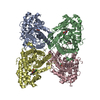 2ot1C 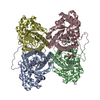 1zahS C: citing same article ( S: Starting model for refinement |
|---|---|
| Similar structure data |
- Links
Links
- Assembly
Assembly
| Deposited unit | 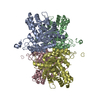
| ||||||||
|---|---|---|---|---|---|---|---|---|---|
| 1 |
| ||||||||
| Unit cell |
| ||||||||
| Details | The biological assembly is the homotetramer found in the asymmetric unit |
- Components
Components
| #1: Protein | Mass: 39263.672 Da / Num. of mol.: 4 Source method: isolated from a genetically manipulated source Source: (gene. exp.)   #2: Protein/peptide | Mass: 1782.553 Da / Num. of mol.: 4 / Source method: obtained synthetically Details: The sequence of the peptide occurs naturally in human Wiskott-Aldrich syndrome protein References: UniProt: P42768 #3: Water | ChemComp-HOH / | |
|---|
-Experimental details
-Experiment
| Experiment | Method:  X-RAY DIFFRACTION / Number of used crystals: 1 X-RAY DIFFRACTION / Number of used crystals: 1 |
|---|
- Sample preparation
Sample preparation
| Crystal | Density Matthews: 2.25 Å3/Da / Density % sol: 45.23 % |
|---|---|
| Crystal grow | Temperature: 298 K / Method: vapor diffusion, hanging drop / pH: 7.5 Details: HEPES, MgCl2, PEG 550 MME, pH 7.5, VAPOR DIFFUSION, HANGING DROP, temperature 298K |
-Data collection
| Diffraction | Mean temperature: 100 K |
|---|---|
| Diffraction source | Source:  SYNCHROTRON / Site: SYNCHROTRON / Site:  APS APS  / Beamline: 22-BM / Wavelength: 1 / Beamline: 22-BM / Wavelength: 1 |
| Detector | Date: Jun 7, 2006 |
| Radiation | Protocol: SINGLE WAVELENGTH / Monochromatic (M) / Laue (L): M / Scattering type: x-ray |
| Radiation wavelength | Wavelength: 1 Å / Relative weight: 1 |
| Reflection | Resolution: 2.05→50 Å / Num. all: 91889 / Num. obs: 91889 / % possible obs: 99.8 % / Redundancy: 3.4 % / Rsym value: 0.105 / Net I/σ(I): 13.1 |
| Reflection shell | Resolution: 2.05→2.16 Å / Redundancy: 3.1 % / Mean I/σ(I) obs: 2.2 / Num. unique all: 13046 / Rsym value: 0.459 / % possible all: 99.9 |
- Processing
Processing
| Software |
| |||||||||||||||||||||||||
|---|---|---|---|---|---|---|---|---|---|---|---|---|---|---|---|---|---|---|---|---|---|---|---|---|---|---|
| Refinement | Method to determine structure:  MOLECULAR REPLACEMENT MOLECULAR REPLACEMENTStarting model: PDB ENTRY 1ZAH Resolution: 2.05→50 Å / Isotropic thermal model: anisotropic / Cross valid method: THROUGHOUT / σ(I): 1
| |||||||||||||||||||||||||
| Displacement parameters |
| |||||||||||||||||||||||||
| Refine analyze |
| |||||||||||||||||||||||||
| Refinement step | Cycle: LAST / Resolution: 2.05→50 Å
| |||||||||||||||||||||||||
| Refine LS restraints |
| |||||||||||||||||||||||||
| LS refinement shell | Resolution: 2.05→2.16 Å
|
 Movie
Movie Controller
Controller


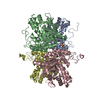
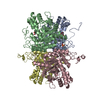
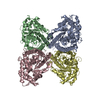
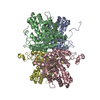
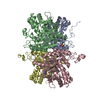
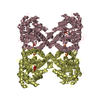
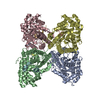
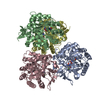
 PDBj
PDBj











